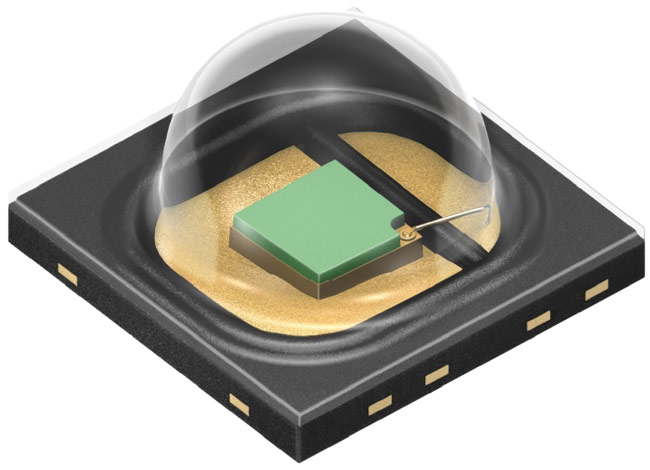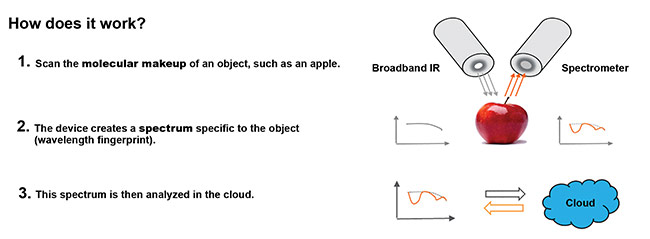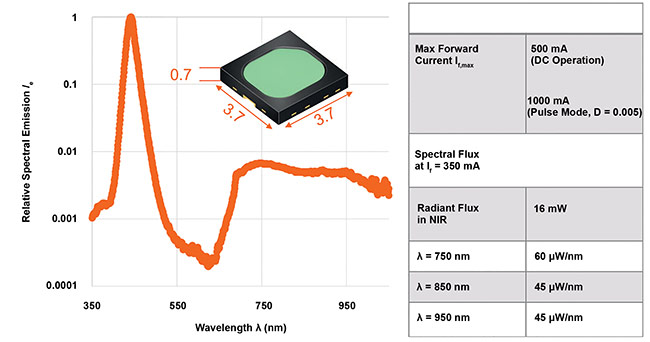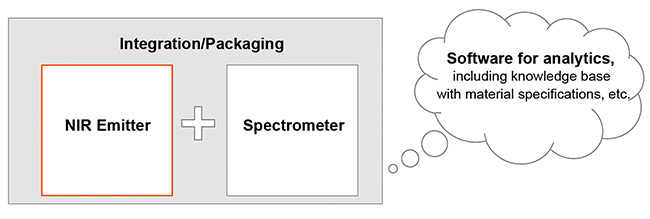Advancements to NIR LED emitters are helping to grow the product portfolio for mobile spectroscopy and opening new application fields for well-being and health monitoring for consumers.
CAROLA DIEZ, OSRAM OPTO SEMICONDUCTORS GMBH
The growing number of health-conscious consumers has accelerated the market for wearables and smart mobile devices, enabling almost everyone to monitor their vital signs. A next goal for such technology is to help consumers monitor ingredients in their food. Consumers will soon be able to use their smartphones to check the freshness of supermarket food, measure the calories in restaurant meals, and verify whether a medication is valid and contains its prescribed contents.

Consumers will soon be able to use their smartphones to check food freshness at the supermarket. Courtesy of OSRAM.
Near-infrared (NIR) spectroscopy uses the characteristic light absorption behavior of certain molecular compounds. Directing a defined spectrum at a sample makes it possible to determine the presence and quantity of certain ingredients from the wavelength distribution of the reflected light. This method is used in the food and agriculture industries, among other sectors. It is possible, for example, to measure the water, fat, carbohydrate, sugar, and protein content of food. This data provides an indication of freshness, quality, and calorie content.
Spectroscopy in use
To classify an unknown material, spectroscopy can identify functional groups, which makes it easier to determine the identity of raw materials as well as contaminants. IR spectroscopy is one of the most common spectroscopic techniques used by organic and inorganic chemists. Simply put, it measures absorption of different IR frequencies in a sample positioned in the path of an IR beam. It uses the absorption behavior to determine molecular compounds. Every molecule absorbs light at several specific wavelengths; this absorption spectrum is unique and acts as a fingerprint for a particular molecule.
The main goal of IR spectroscopic analysis is to determine the chemical functional groups in a sample. Different functional groups absorb their own characteristic frequencies of IR radiation. Using various sampling accessories, IR spectrometers can accept a wide range of sample types, such as gases, liquids, and solids. Thus, IR spectroscopy is an important and popular tool for structural elucidation and compound identification.

New phosphor technology and an integrated lens produce more than twice the output compared to the first generation of broadband-emitting IR LEDs. (Shown: Osram Opto SFH 4736). Courtesy of OSRAM.
As a next step in the scientific use of spectroscopy, a new generation of devices is emerging that utilizes broadband NIR emitters and compact spectrometers, and connects to a knowledge database via cloud technology to compare the data with material and reference specifications for the analysis. By analyzing the absorption spectrum of an unknown material and matching the measurement with a database of known molecules, it is possible to determine the presence and quantity of certain ingredients, such as the percentage of cocoa in your favorite chocolate bar.
The spectroscopy ecosystem, therefore, consists of three main parts: an NIR LED emitter (NIRED), a spectrometer, and software for the analysis, with access to a knowledge database that includes material and reference specifications.
Over the past several years, newly developed IR LED solutions have paved the way for NIR spectroscopy’s entry into the consumer market for applications such as everyday food analytics. The optoelectronic components are now small enough for smartphone add-ons and similar options. The first-ever NIRED, developed
in 2016 by OSRAM Opto Semiconductors has a wavelength range of 650 to 1050 nm.
The basis of this LED is a blue 1-mm² chip in UX:3 technology. Its light is converted into IR radiation with the aid of a phosphor converter developed specifically for consumer food analytics. A residual blue component in the light helps users target the area they want to investigate.

A new generation of devices is emerging that utilizes broadband NIR emitters and compact spectrometers, and can connect to a knowledge
database via cloud technology to compare data with material and reference specifications for analysis. Courtesy of OSRAM.
Since the first NIRED was made, developers have succeeded in increasing the intensity of the light by an impressive 60 percent compared to its predecessor by making improvements to the phosphor material and lens technology. The NIRED lenses ensure strong directional light, improving overall system efficiency, while the primary optics now bundle 90 percent of the generated light within a narrow beam angle of ±40°, providing considerably more optical power per unit area on the target object — in other words, focusing the light precisely where it is needed. As a result, more light is reflected to the spectrometer, leading to a stronger measured signal. Until now in spectroscopy, separate optics were needed to focus the light.
The stronger measured signal creates an improved signal-to-noise ratio for the spectroscopic analysis of food and medicine — and in a very small package size, which qualifies the broadband IR LED to be integrated into space-restricted devices, such as smartphones or tablets.
New applications, new demands
The health-conscious consumer market is expected to be one of the main drivers for NIR spectroscopy, but other application fields include smart farming.

NIR spectroscopy based on LED technology (NIRED) helps farmers monitor the growth
of their crops and plan the ideal time for harvest. Courtesy of OSRAM.
One of the most important decisions farmers and vineyard owners have to make involves timing the harvest correctly. The right timing ensures the produce has the best possible taste but also means precious time and money can be saved at the subsequent processing and shipment stages.
NIR spectroscopy based on LED technology can help users determine the timing by simply scanning fruits, vegetables, or cereal crops with the NIRED and a spectrometer installed in a smartphone or tablet to get reliable information about the sugar, water, and fat content. The system makes use of the absorption behavior of certain molecular compounds. The NIRED irradiates a specimen with a defined spectrum of light and a spectrometer is used to measure the wavelength distribution of the reflected light. These measurements indicate the existence and quantity of certain ingredients. The farmer in the field or the vineyard owner at the vine can now take samples and easily monitor the progress of their crops in real time, so they can plan the ideal time for the harvest.

The small package size enables broadband IR LED to be integrated into space-restricted devices such as smartphones. Courtesy of OSRAM.
Different application fields create specific demands. Among them, an extremely compact form factor for mobile applications, or a strong signal and a single optic for agriculture.
Partnering for solutions
Using the new broadband IR light, the first minispectrometers have already been showcased with a compact LED as a light source for NIR spectroscopy. For example, an Israeli startup has developed an NIR microspectrometer that is smartphone operated and cloud connected. Resembling a matchbox in shape and size, the device was developed for the end-consumer sector. The solution leverages IR spectroscopy to identify certain compounds — fat, sugar, water, and proteins — in food. This leads to information about calorie content, freshness, and food quality, which helps consumers to better monitor their health and reach fitness goals.
As described, the microspectrometer absorbs light reflected from an object, breaks it down into a spectrum, and analyzes it to determine the object’s chemical makeup. It can scan a wide range of materials — food, medicine, and even the human body — and analyze them in real time. This instantly provides consumers and businesses with relevant and actionable insights about the physical world.

Phosphor conversion to the IR spectral range, enabling technology for mobile spectroscopy. The table above depicts the first NIRED system,
developed by OSRAM. Courtesy of OSRAM.
The microspectrometer employs embedded emitter technology, which is enabling solution providers to integrate spectrometers directly into mobile devices such as smartphones and tablets. These types of devices are bringing spectrometry to both consumers and enterprises. Farmers can now analyze the nutritional contents and dry matter in a variety of feed types. This is a big deal because what cows eat and how much they eat directly affects the farm’s milk production. Dairy cows require a precise intake of dry matter and nutrients. Not enough dry matter and they produce less milk. Too much and it influences the cow’s digestion, resulting in lower production and wasted feed.

A spectroscopy ecosystem must contain three main parts: an NIR emitter, a spectrometer,
and software for analysis, with access to a knowledge database of material and reference
specifications. Courtesy of OSRAM.
Until now, no definitive, inexpensive way existed to analyze feed types and ensure dairy cows were eating precisely what they should be eating. But with the help of NIR spectroscopy, dairy farms can cut costs and increase productivity by accurately measuring and analyzing dry matter. Farmers can carry NIR spectroscopy-based devices in their pockets to get lab-grade results in less than a minute. Previously, the spectral analysis of materials was pretty much limited to academic research. Everyday application of spectral analysis is transforming the way we think about food, fitness, and medication.
With new generations of devices emerging, consumers will soon be able to verify the active ingredients in their medicines, find the juiciest apples at the grocery store, and discover how much fat is in the cheese — all by simply scanning each item with their smartphone.
Meet the author
Carola Diez, Ph.D., is senior marketing manager at OSRAM Opto Semiconductors, where she is also responsible for business development of broadband LEDs for NIR spectroscopy. She studied physics at the Karlsruhe Institute of Technology (KIT) and Heriot-Watt University, Edinburgh and has a Ph.D. in physics from the University of Augsburg in Germany.